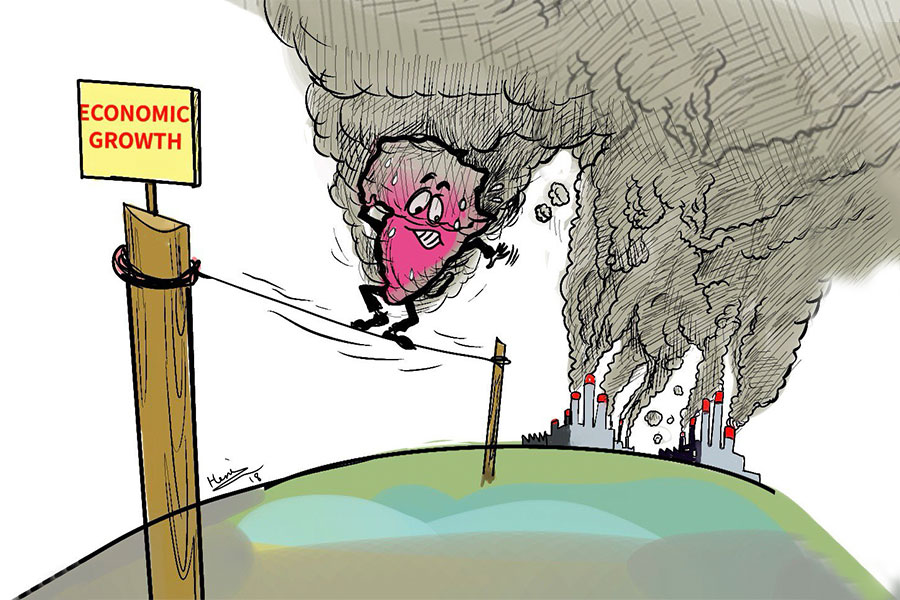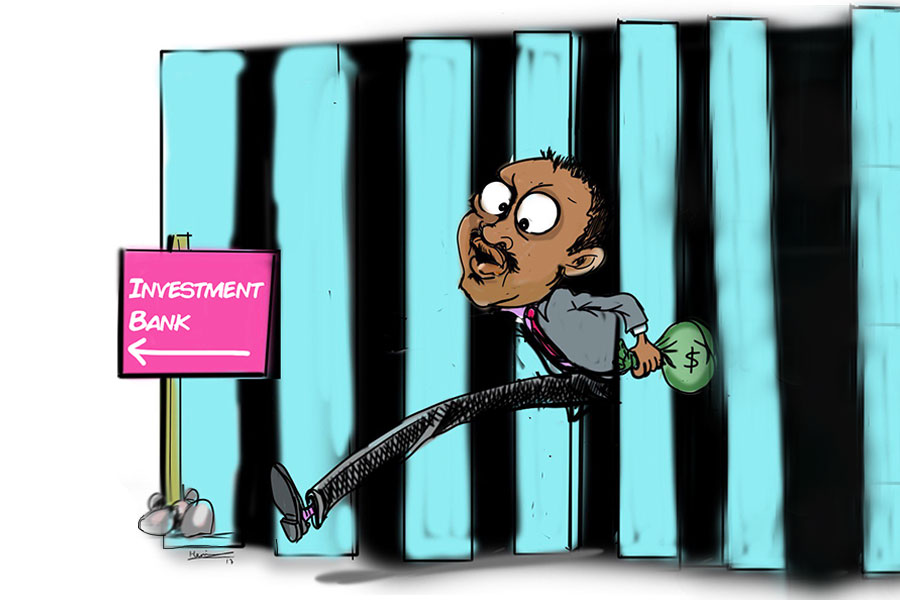The performance of the Commercial Bank of Ethiopia (CBE) in the 2023/24 financial year was one of impressive growth interwoven with deep-seated issues. Marked by substantial increases in profits, assets, and customer numbers, CBE provided a snapshot of a financial institution that is both a powerhouse and a potential point of vulnerability.
As the largest lender, the state-owned CBE continued to command nearly half of the banking industry’s assets and deposits. Even as its market share fell slightly compared to previous years, the Bank’s total assets and deposits still accounted for 47.9pc and 47.1pc of the industry, respectively, while its capital comprised 24.2pc of the industry’s aggregate.
Since its incorporation in 1942, CBE has been the anchor of the financial infrastructure. Over the past year, its performance demonstrated a finely tuned operation that resulted in robust returns even in a constrained economic environment.
However, behind the impressive figures lie structural issues that analysts say call for comprehensive reforms, not only within the Bank itself but also across the wider industry. CBE’s iconic and imposing 48-storey headquarters on Ras Desta Damtew St., may symbolise the Bank’s might, but experts believe that the real focus should be on strengthening the balance sheet, ensuring prudent risk management, and improving governance transparency.
The Bank reported a profit of 22.02 billion Br, a 26.2pc rise over the previous year. The increase was driven by net interest and non-interest incomes. Net interest income surged by 34.2pc to reach 56.55 billion Br, even as interest expenses dipped by 2.6pc to 44.49 billion Br. This was despite an 11.6pc rise in deposits, bringing the total to 1.176 trillion Br.
Industry observers see such a tilt in the income statement as a strategic focus on lowering deposit mobilisation costs or a deliberate repricing of legacy liabilities. Nonetheless, the trend has raised questions about whether these gains can be maintained over the long term.
Non-interest income grew by 22.9pc to 34.1 billion Br. However, it is partially offset by a substantial decline in forex gains, which dropped by one-third to 2.21 billion Br. The reduction in forex income revealed either a tightening of foreign exchange availability or a more conservative approach in booking such gains, signalling a notable shift in the Bank’s revenue composition.
Analysts caution that beneath the headline numbers, however, are several issues that could undermine long-term stability. Operational costs continue to climb amid an ever-growing staff base that now exceeds 48,000 permanent and 33,000 temporary employees. Total operating expenses rose by 14pc to 110.8 billion Br. Salaries and benefits saw a 17pc uptick, reaching 35.26 billion Br, while other operating expenses spiked by 65.4pc to 21.52 billion Br.
These jumps were partly driven by a 3.17 billion Br contribution to the newly mandated deposit insurance fund and an increase of 4.31 billion Br in miscellaneous costs. Analysts like Abdulmenan Mohammed (PhD), a finance expert based in London, warn that these rising costs could signal the start of a more expensive compliance and operational environment. He also noted that inflationary pressures might soon add further strain on the Bank’s already stretched resources.
CBE’s total assets grew by 9.9pc to 1.44 trillion Br, a slowdown from the previous year’s robust 19.1pc increase, largely due to the tighter monetary policy from the National Bank of Ethiopia (NBE).
Loans, advances, and bond holdings increased by 10.8pc to 1.19 trillion Br, while deposits climbed by 11.6pc. CBE expanded its customer base substantially by adding 1.3 million new account holders, bringing the total number of customers to 7.3 million.
Over the year, the Bank disbursed more than 218 billion Br in loans, with 90.8pc of that amount going to the private sector. A key indicator of the Bank’s aggressive lending strategy is its loan-to-deposit ratio. One measure of this ratio stood at 101.2pc, an improvement from the previous year’s 111pc. However, other reports have placed the ratio at 91.2pc, still much higher than the industry average of around 64pc.
These figures illustrated how tightly the Bank is leveraging its funding sources to maintain aggressive lending. This practice can boost returns but leaves little room for error if a wave of withdrawals or a downturn in economic conditions occurs.
CBE’s capital and non-distributable reserves increased by 16.4pc to 72.47 billion Br. Despite this growth, the reserves still account for over five percent of total assets, unveiling a vulnerability in its capital structure. The Bank’s capital buffers are reported at 6.1pc of total assets, a level that lags behind international standards and falls short of the domestic industry’s average of 8.4pc. The thin cushion is further emphasised by the Bank’s asset-to-equity ratio, which was 16.3 times, revealing the considerable leverage that has been employed.
Liquidity remains another area of concern.
Although cash and cash equivalents grew by 4.8pc to 193.54 billion Br, their share of total assets and deposits decreased slightly to 13.47pc and 14.2pc, respectively. The contraction in relative liquidity has raised alarms among analysts like Abdulmenan, who warn that the Bank’s financial flexibility could be jeopardised if a few of its largest depositors were to withdraw their funds suddenly.
A recent report from the NBE disclosed that while CBE’s capital adequacy ratio of 22.03pc is above the regulatory minimum, its liquidity position might fall short of the required threshold under stress conditions.
Adding to these concerns is CBE’s heavy reliance on external liabilities. A notable case was the 100.58 billion Br loan from the Central Bank, which underlined CBE's structural dependency on state support.
The Bank’s investments, particularly those extended to state-owned enterprises and supported by government guarantees, are increasingly vulnerable as public debt climbs and fiscal space tightens.
“CBE’s capital position requires targeted policy and regulatory attention in the event of unfavorable circumstances,” said Abdulmenan.
His caution echoed broader worries about the risk inherent in a bank that has long been considered a pillar of stability.
CBE’s profitability metrics offer a mixed picture.
Its return on assets (RoA) increased modestly from 1.80pc to 1.94pc, revealing that it is generating slightly more profit for each unit of asset deployed. Return on equity (RoE) also improved, rising to 32.8pc, growing by 2.8 percentage points over the previous year.
However, despite these gains, the Bank’s net profit margin remains low at 1.53pc, which is modest by international standards. The slim margin uncovered that administrative and operating expenses continue to weigh heavily on the bottom line, even as total earnings have grown by more than 20pc.
The Bank’s evolution over the decades has not been limited to financial metrics alone. It has been a pioneer in introducing banking services to the market, such as ATMs, money transfer services, and even interest-free banking in the 1990s.
Since assuming office in March 2020, Abie Sano, president of the Bank, has overseen a period marked by robust top-line metrics, cautious capital buildup, and tactical debt leveraging.
Abie, who completed his undergraduate studies in accounting at Addis Abeba University and pursued postgraduate studies in business administration at the University of London, has steered the CBE through trying economic times while ensuring steady growth.
With a network of 1,942 branches spread across the country and correspondent relationships with 38 foreign banks, CBE plays a crucial role in the financial sector. Its outsized market share entails that any significant distress within its operations would have far-reaching implications for the entire financial system. This interconnectedness makes it a bellwether for the stability of the banking industry and the broader economy.
A system glitch in March 2024 led to unauthorised withdrawals that could have undermined depositor confidence. CBE disclosed that 99.4pc of the 801.4 million Br involved in the affected transactions had been recovered by the year's end.
“It’s a significant achievement for CBE,” said Abie. “Even the most technologically advanced banks worldwide facing similar incidents have often been less successful in recovering their funds.”
The episode not only uncovered the Bank’s technological vulnerabilities but also demonstrated its swift ability to manage and mitigate risks.
Despite these recovery efforts, the broader picture remains nuanced. CBE’s expansive growth was manifested in its continued dominance in the banking industry.
However, the Bank’s aggressive expansion and reliance on public sector projects have not come without risks. Past overexposure to public projects has, at times, placed it under considerable stress. A year ago, impairment losses on loans and advances had surged dramatically — by 8.7 times — raising concerns about the quality of its credit portfolio.
Although this year’s 19pc increase in provisioning, amounting to 9.5 billion Br, appears more moderate, some analysts fear that it could still be masking underlying issues with non-performing loans. In an environment where year-on-year inflation reached 20pc and foreign currency shortages remain a persistent issue, any deterioration in credit quality could exacerbate liquidity problems.
The Bank’s strategy of relying heavily on deposits, accounting for over 80pc of its funding, provides some insulation from external borrowing pressures. However, this strength also means that a large portion of its resources is tied up in loans.
The Bank’s capital adequacy also remains an area of vulnerability. Although it contributed 22.5pc to the industry’s total capital of 277.8 billion Br, its own capital buffers, at 6.1pc of total assets, fall short of international benchmarks and the domestic industry average of 8.4pc. This thin capital cushion, coupled with an asset-to-equity ratio of 16.3 times, revealed a considerable level of leverage that could expose the Bank to heightened losses in the event of an economic downturn.
These structural challenges occur at a time when the broader economy is gripped by persistent inflation and severe foreign currency shortages. Such conditions escalate the risk of credit quality deterioration and further liquidity constraints.
PUBLISHED ON
Apr 06, 2025 [ VOL
26 , NO
1301]

Dec 22 , 2024 . By TIZITA SHEWAFERAW
Charged with transforming colossal state-owned enterprises into modern and competitiv...

Aug 18 , 2024 . By AKSAH ITALO
Although predictable Yonas Zerihun's job in the ride-hailing service is not immune to...

Jul 28 , 2024 . By TIZITA SHEWAFERAW
Unhabitual, perhaps too many, Samuel Gebreyohannes, 38, used to occasionally enjoy a couple of beers at breakfast. However, he recently swit...

Jul 13 , 2024 . By AKSAH ITALO
Investors who rely on tractors, trucks, and field vehicles for commuting, transporting commodities, and f...

Sep 13 , 2025
At its launch in Nairobi two years ago, the Africa Climate Summit was billed as the f...

Sep 6 , 2025
The dawn of a new year is more than a simple turning of the calendar. It is a moment...

Aug 30 , 2025
For Germans, Otto von Bismarck is first remembered as the architect of a unified nati...

Aug 23 , 2025
Banks have a new obsession. After decades chasing deposits and, more recently, digita...